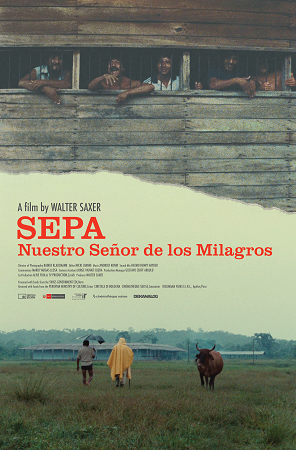
Sepa: Nuestro Señor De Los Milagros 1987
Distributed by Good Docs
Produced by Walter Saxer
Directed by Walter Saxer
Streaming, 72 mins
College - General Adult
Agriculture; Human Rights; Penal Institutions
Date Entered: 06/14/2023
Reviewed by Gisèle Tanasse, University of California BerkeleyThe recently restored and redistributed 1987 Walter Saxer documentary Sepa: Nuestro Señor de los Milagros (Sepa: Our Lord of Miracles) transports the viewer back in time to a vibrant experimental open air penal colony in the Peruvian Amazon. Part utopia, part “green hell,” Sepa offered the opportunity for prisoners to escape Lima’s horrendously overcrowded traditional prisons, where violent gangs, drugs, torture, and even deadly hostage situations ran rampant. While Sepa’s warden appears genuinely well-loved by prisoners, due to corruption or, at best, incompetence, 70 paroled Sepa prisoners are left languishing many months in limbo without paperwork; moreover, communication with the outside world is nearly impossible from Sepa, leaving prisoners with no assistance or contact from family outside the remote colony.
Filled with upbeat Peruvian folk music, dance and cooking, Sepa: Nuestro Señor de los Milagros is highly recommended for courses in Anthropology, Latin American Studies, Incarceration Studies, Documentary Film Studies, Music and Gender Studies. This in-depth and balanced study of the benefits and drawbacks to an agricultural open air penal colony provides a truly unique opportunity to consider and discuss alternate approaches to prisoner rehabilitation. It is important to note that the film does include brief yet very graphic and disturbing footage of real violence and torture of hostages from a traditional Lima prison. Despite the clear pain and tragedy that runs throughout this first-hand immersion in Peru’s decidedly unjust criminal justice system in the 1980s, it is also a joy-filled film that is incredibly engaging to watch due in no small part to the care Saxer took to empower each prisoner to tell their own story, against the backdrop of a beautiful verdant landscape. The greatest Sepa miracle may be that this wonderful film, once lost, has been restored for a new generation.
Published and licensed under the Creative Commons Attribution 4.0 license. Anyone can use these reviews, so long as they comply with the terms of the license.